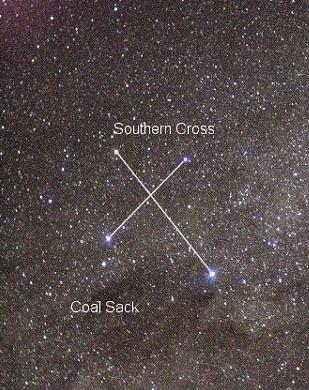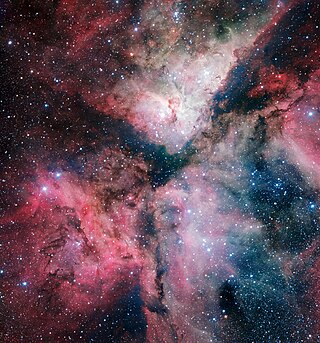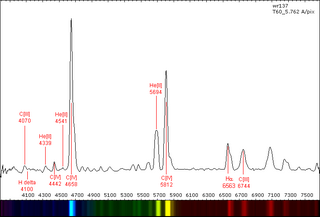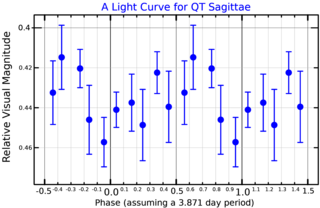
WR 136 is a Wolf–Rayet star located in the constellation Cygnus. It is in the center of the Crescent Nebula. Its age is estimated to be around 4.7 million years and it is nearing the end of its life. Within a few hundred thousand years, it is expected to explode as a supernova.

WR 124 is a Wolf–Rayet star in the constellation of Sagitta surrounded by a ring nebula of expelled material known as M1-67. It is one of the fastest runaway stars in the Milky Way with a radial velocity around 200 km/s. It was discovered by Paul W. Merrill in 1938, identified as a high-velocity Wolf–Rayet star. It is listed in the General Catalogue of Variable Stars as QR Sagittae with a range of 0.08 magnitudes.

WR 46 is a Wolf-Rayet star in the constellation of the Southern Cross of apparent magnitude +10.8. It is located at 55 arcmin north of Theta2 Crucis. The star is a member of the distant stellar association Cru OB4, and is around 2,900 parsecs or 9,300 light years from the Solar System.

WR 24 is a Wolf-Rayet star in the constellation Carina. It is one of the most luminous stars known. At the edge of naked eye visibility it is also one of the brightest Wolf Rayet stars in the sky.
WR 147 is a multiple star system in the constellation of Cygnus. The system is extremely reddened by interstellar extinction – that is, dust in front of the star scatters much of the blue light coming from WR 147, leaving the star appearing reddish.

WR 134 is a variable Wolf-Rayet star located around 6,000 light years away from Earth in the constellation of Cygnus, surrounded by a faint bubble nebula blown by the intense radiation and fast wind from the star. It is five times the radius of the sun, but due to a temperature over 63,000 K it is 400,000 times as luminous as the Sun.
WR 142 is a Wolf-Rayet star in the constellation Cygnus, an extremely rare star on the WO oxygen sequence. It is a luminous and very hot star, highly evolved and close to exploding as a supernova. It is suspected to be a binary star with a companion orbiting about 1 AU away.
BAT99-98 is a Wolf-Rayet star in the Large Magellanic Cloud. It is located near the R136 cluster in the 30 Doradus nebula. At 226 M☉ and 5,000,000 L☉ it is currently one of the most massive and luminous stars known.

WR 102 is a Wolf–Rayet star in the constellation Sagittarius, an extremely rare star on the WO oxygen sequence. It is a luminous and very hot star, highly evolved and close to exploding as a supernova.

BC Cygni is a red supergiant and pulsating variable star of spectral type M3.5Ia in the constellation Cygnus.
WR 135 is a variable Wolf-Rayet star located around 6,000 light years away from Earth in the constellation of Cygnus, surrounded by a faint bubble nebula blown by the intense radiation and fast wind from the star. It is just over four times the radius of the sun, but due to a temperature of 63,000 K it is 250,000 times as luminous as the sun.

WR 137 is a variable Wolf-Rayet star located around 6,000 light years away from Earth in the constellation of Cygnus.
WR 111 is a Wolf-Rayet (WR) star in the constellation Sagittarius. It is magnitude 7.8 and lies about 5,150 light-years away. It is one of the brightest and most closely studied WR stars.
WR 3 is a Wolf-Rayet star located around 9,500 light years away from Earth in the constellation of Cassiopeia.

HD 152408, also known as WR 79a, is a Wolf-Rayet star located in the constellation Scorpius, close to the galactic plane. Its distance is around 2,020 parsecs away from the Earth.

WR 128 is a Wolf–Rayet star located about 9,500 light years away in the constellation of Sagitta. A member of the WN class, WR 128's spectrum resembles that of a WN4 star, but hydrogen is clearly present in the star, making it the only known hydrogen-rich WN4 star in the galaxy. However, similar H-rich very early WN stars can be found in the LMC and especially in the SMC, but the only other galactic examples of this are WR 3 and WR 152.
WR 150 is a Wolf-Rayet star in the constellation of Cygnus. It is one of the early-type carbon sequence (WCE), and is of spectral type WC5. WR 150 is very far from the Earth, being 28,500 light-years from it.

WR 120 is a binary containing two Wolf-Rayet stars in the constellation of Scutum, around 10,000 light years away. The primary is a hydrogen-free weak-lined WN7 star, the secondary is a hydrogen-free WN3 or 4 star, and the system is a possible member of the cluster Dolidze 33. From our point of view, WR 120 is reddened by 4.82 magnitudes, and it has the variable designation of V462 Scuti.

HD 326823, also known as V1104 Scorpii, is a binary star containing a unique emission-line star, which is in the midst of transitioning to a nitrogen-rich Wolf-Rayet star, as well as being a candidate Luminous blue variable, located 4,142 light years away in the constellation of Scorpius. The primary is very evolved, because it is composed of almost entirely helium, and only 3% of it is still hydrogen, and it has lost most of its mass to the now-very-massive secondary. The underlying mechanisms and mass transfers in the system are comparable to other W Serpentis systems, such as Beta Lyrae and RY Scuti.
WR 119 is a Wolf–Rayet star located about 10,500 light years away in the constellation Scutum. WR 119 is classified as a WC9 star, belonging to the late-type carbon sequence of Wolf-Rayet stars. WR 119 is noteworthy for being the least luminous known Wolf-Rayet star, at just over 50,000 L☉. The most recent estimate is even lower, at just 42,700 L☉, based on the most recent analysis using Gaia DR2 data.












